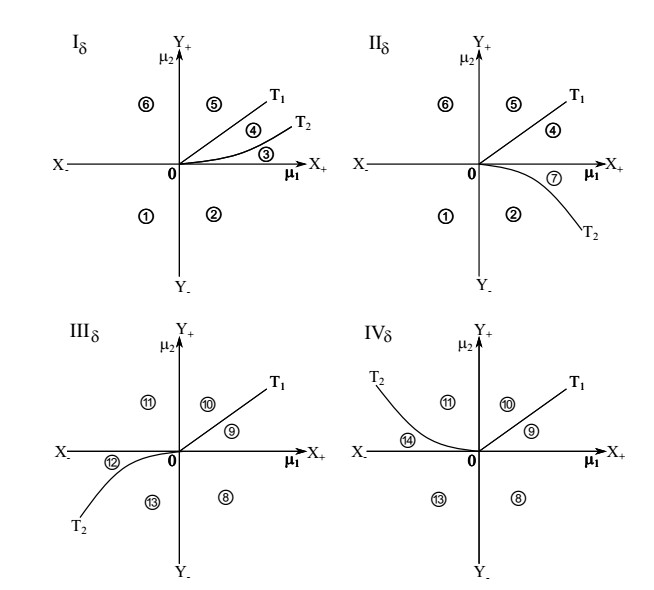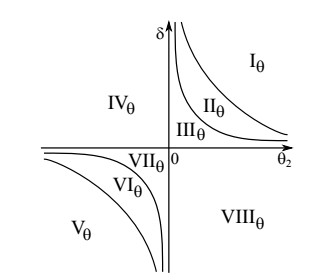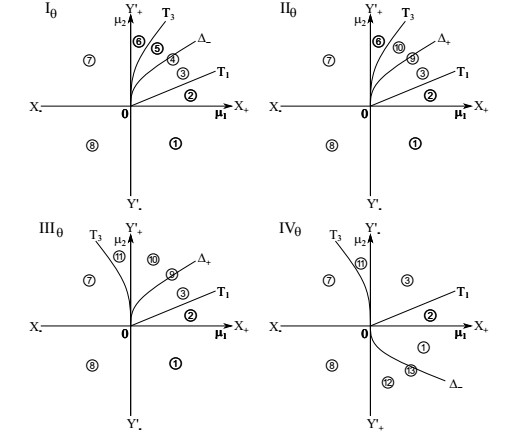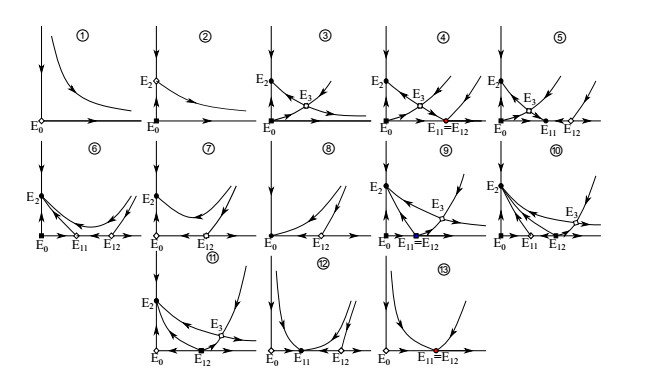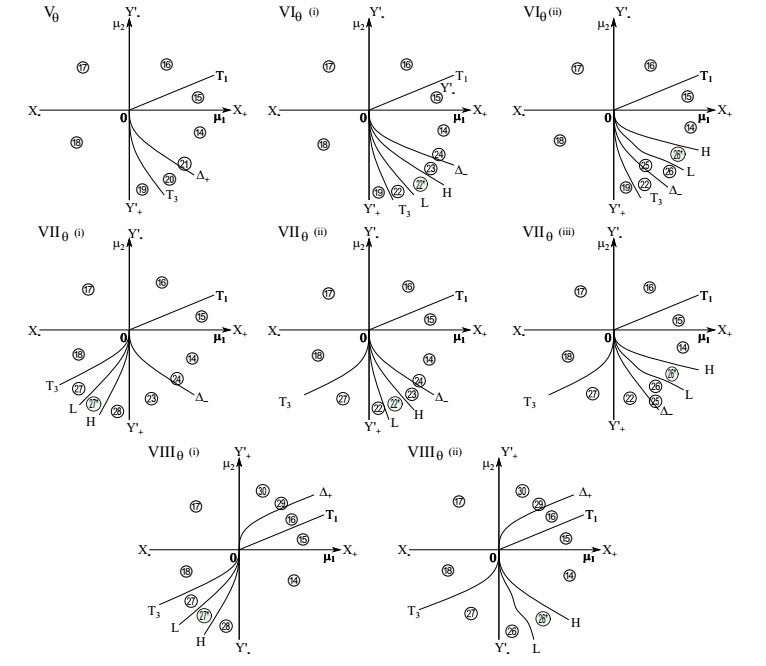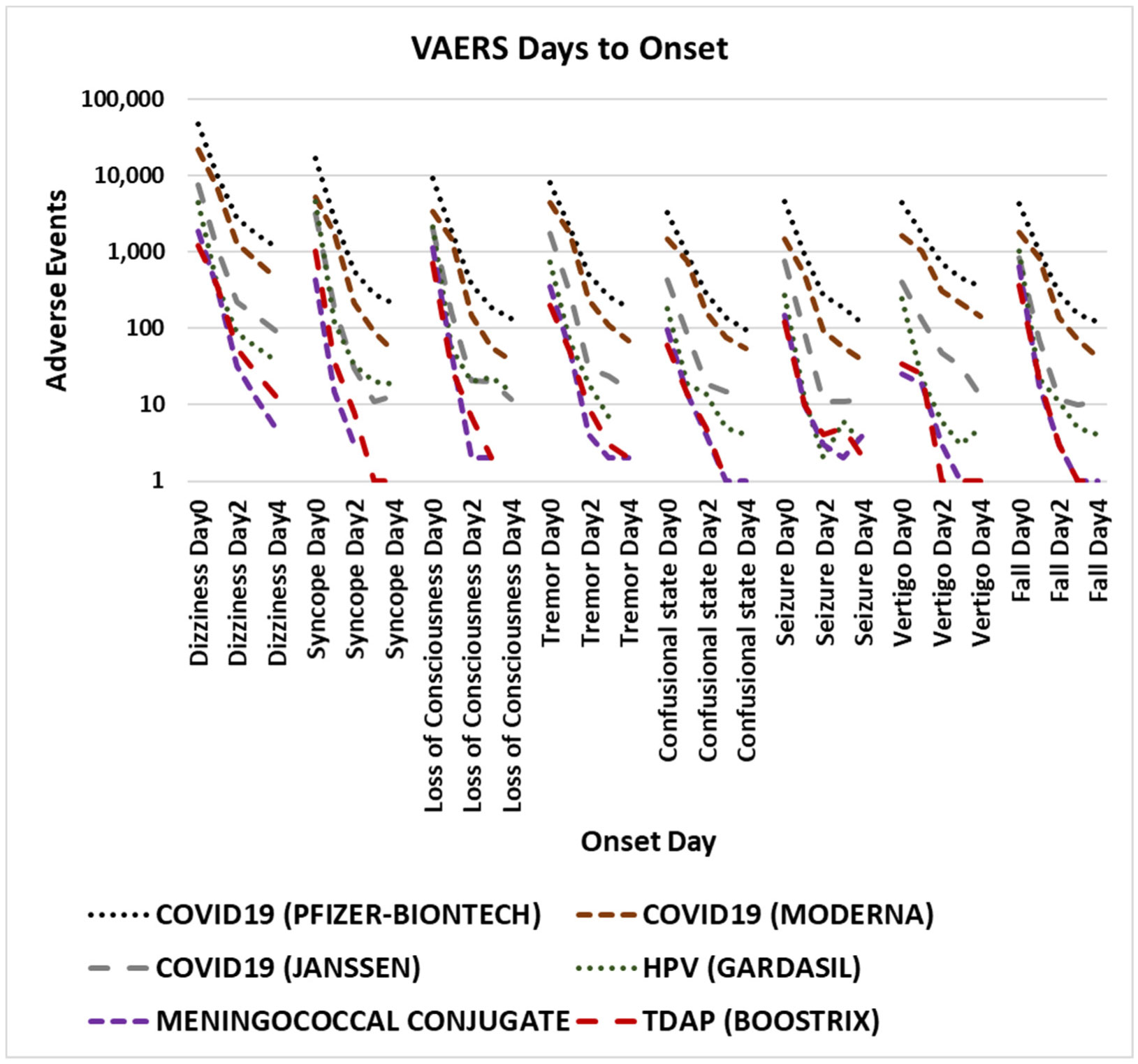1.
Introduction
The theory of bifurcations is crucial in understanding qualitative properties of differential systems depending on one or more parameters. Bifurcations of codimension one and two are well-addressed in the literature [1,2,3] when they are non-degenerate, but many open problems emerge when they become degenerate [4] or the codimension is beyond 2.
The classical normal form of the double-Hopf bifurcation in differential systems of dimension 4 is based on six generic conditions (HH.0)–(HH.5) [1]. Some of the pioneering papers reporting results on non-degenerate double-Hopf bifurcation are references [5,6,7,8].
If one or more generic conditions fail to be satisfied, a degeneracy arises and, thus, the generic results are not valid anymore. In this work we study two degenerate double-Hopf bifurcations. The degeneracy we refer at is related to generic conditions which are necessary in obtaining normal forms.
Another added value of our results is that we discovered new bifurcation diagrams and new phase portraits and, thus, new properties of double-Hopf bifurcation which, to our knowledge, were not previously reported in the literature. The results emerged from the analysis of a new system which appeared due to degeneracy.
Our study is performed in a general framework and produces generic results which can be applied in particular systems exhibiting this bifurcation. The double-Hopf bifurcation (degenerate or not) can be often met in practical models based on differential systems and having a large number of equations (at least four) [4,9,10,11,12]. Interesting results on discrete time systems undergoing double-Hopf bifurcations are presented in [11]. Thus, understanding better this bifurcation and obtaining new generic properties of it is desirable and important for particular models describing real-world phenomena. This is the purpose of the present work.
The paper is organized as follows. In Section 2 the classical normal form obtained in [1] using six generic conditions (HH.0)–(HH.5) is presented and a new normal form up to order 3 in polar coordinates is obtained as two of the generic conditions, namely (HH.1) and (HH.3) fail. In Section 3, the dynamics and bifurcation of this normal form, around the origin, is analyzed as the condition (HH.3) is not satisfied, but (HH.1) is valid, while in Section 4 a similar study is done when the condition (HH.1) is not fulfilled, but (HH.3) is satisfied. In Section 5 some conclusions and the relationship between the dynamics of the 2D amplitude system and the dynamics of the 4D truncated normal form are given.
2.
About the double-Hopf bifurcation
Consider a differential system of the form
with f smooth, ˙x=dxdt, and assume that x=0 is an equilibrium point of the system for all α with |α|=√α21+α21 small enough, that is, f(0,α)≡0; x=0 stands for x=(0,0,0,0) and α=0 for α=(0,0). The system (2.1) can be written as
where F(x,α)=O(|x|2) is a smooth function denoting Taylor rest with terms of order at least 2.
Assume the matrix A(α) has two pairs of simple complex-conjugate eigenvalues λ1, ¯λ1, λ2, ¯λ2,
for all sufficiently small |α|, where μ1,2(α) and ω1,2(α) are smooth functions of α such that μ1(0)=μ2(0)=0, respectively, ω1(0)=ω10>0 and ω2(0)=ω20>0. When these conditions are satisfied, the origin of system (2.1) is called a double-Hopf or Hopf-Hopf singularity, and, under supplementary conditions, a double-Hopf bifurcation occurs at α=0.
In complex coordinates, the system (2.2) can be further reduced to the form
where
and
Other two equations are the conjugates of system (2.3) and are omitted in what follows.
A first normal form corresponding to system(2.3) is described in the following lemma, reported in [1].
Lemma 2.1. Assume that the following conditions take place [1]
Then, there exists a locally defined, smooth and smoothlyparameter-dependent, invertible transformation of the complex variables thatreduces system (2.3) for all sufficiently small |α| into the following form:
where w1,2 are complex-valued functions, ‖(w1,¯w1,w2,¯w2)‖2=|w1|2+|w2|2.
In system (2.4) we used the following notations: a1+ib1=G2100(α), a2+ib2=G1011(α), a3+ib3=G3200(α), a4+ib4=G2111(α) and a5+ib5=G1022(α), respectively, c1+id1=H1110(α), c2+id2=H0021(α), c3+id3=H2210(α), c4+id4=H1121(α) and c5+id5=H0032(α), where ai=ai(α), bi=bi(α), ci=ci(α) and di=di(α), i=¯1,5, are real smooth functions of α which depend on the coefficients gijkl(α) and hijkl(α). The coefficients of third order terms in system (2.4) are given explicitly in [1].
The system (2.4) has been transformed further in [1] to a normal form based on six generic conditions.
In polar coordinates w1=r1eiφ1 and w2=r2eiφ2, the system (2.4) becomes
where the real functions Φk, Ψk are smooth functions of their arguments and are 2π-periodic in φj, Φk=O((r21+r22)3), Ψk(0,0,φ1,φ2)=0.
The main dynamics of the system (2.5) is given by its first two equations
the other two describing only the rate of rotation of an orbit, and, because ω1,2(0)≠0, they can be approximated by
Changing to ρi=r2i, i=1,2, and truncating the higher order terms, system (2.6) leads to the planar system
referred as the amplitude equations; ˙ρi=dρidt, i=1,2.
In the hypotheses
in [1], the system (2.4) has been transformed further into the following normal form
where the real functions Φk, Ψk are smooth functions of their arguments and are 2π-periodic in φj, Φk=O((r21+r22)3), Ψk(0,0,φ1,φ2)=0.
Consequently, the truncated amplitude system obtained in [1] reads:
This system is analyzed in two cases, the "simple case" as p11(0)p22(0)>0 and the "difficult case" as p11(0)p22(0)<0.
The study of the generic Hopf-Hopf bifurcation is also done in [2], starting with the amplitude system (2.6), truncated up to third order terms, in the nondegeneracy hypotheses
and
In this paper we study the degenerate Hopf-Hopf bifurcation when conditions (HH.1) and (HH.3) are not satisfied. In order to do this, we derive a new normal form for the amplitude system.
Theorem 2.2. Assume that the following three generic conditions are satisfied:
(HH.2) a2(0)=Re[G1011(0)]≠0,
(HH.4) c2(0)=Re[H0021(0)]≠0,
(HH.5) the map α↦(μ1(α),μ2(α)) is regular at α=0.
Then, system (2.6) is locally topologically equivalent around theorigin O, for all sufficiently small |α|, tothe following system
where
and
with n2(μ)=−a5(μ)a2(μ) and n1(μ)=−c4(μ)+c1(μ)n2(μ)c2(μ), where pij=pij(μ) for i=1,2 and j=¯1,5, are well-defined and smooth functions for all |μ| small enough.
Proof. We rescale the time by
where ni=ni(α), i=¯1,2, are smooth functions which will be determined later. Then, system (2.6) is orbitally equivalent to the system
where p11=a1+μ1n1, p12=a2+μ1n2, p13=a3+a1n1, p14=a4+a1n2+a2n1, and p15=a5+a2n2, respectively p21=c1+μ2n1, p22=c2+μ2n2, p23=c3+c1n1, p24=c4+c1n2+c2n1 and p25=c5+c2n2.
Since a2(0)≠0 and c2(0)≠0, one can nullify the coefficients p15 and p24 by taking n2(α)=−a5(α)a2(α) and n1(α)=−c4(α)+c1(α)n2(α)c2(α). Notice that n1(α) and n2(α) are well-defined for all |α| small enough, and so are pij(α).
Assume the map α↦(μ1(α),μ2(α)) is regular at α=0, that is,
From the Inverse Function Theorem this condition ensures that for any μ1,μ2∈R with |μ|=√μ21+μ22 small enough, there exist α1=α1(μ) and α2=α2(μ) which are obtained locally from the system
This implies that, one can consider further μ=(μ1,μ2) as the parameter of the system. Thus, ω1,2=ω1,2(μ), ai=ai(μ), bi=bi(μ), ci=ci(μ), di=di(μ), pij=pij(μ), i=1,2, j=¯1,5. Since μ1,2(0)=0, the properties ω1(0)=ω10>0 and ω2(0)=ω20>0 are preserved. The theorem is proved.
Remark that the coefficients pij in system (2.13) are not the same as the ones in system (2.10), but the values p11(0), p12(0), p21(0), p22(0) are the same as in system (2.8).
The truncated 4D system of system (2.13) reads
where p12(0)p22(0)≠0, because p12(0)=a2(0)≠0, from (HH.2) and p22(0)=c2(0)≠0, from (HH.4).
We aim to tackle in this work the normal form system (2.13), truncated up to third order terms, when a2(0)c2(0)>0.
Assume p12(0)=a2(0)<0 and p22(0)=c2(0)<0. Make the changes
The transformation (ρ1,ρ2)⟼(ξ1,ξ2) is well defined for all |μ| small enough, because p12(0)≠0 and p22(0)≠0 are satisfied from (HH.2) and (HH.4), and it is nonsingular as a2(0)c2(0)≠0. Since dξ1dt=−p12(μ)dρ1dτdτdt and dξ2dt=−p22(μ)dρ2dτdτdt, the form system (2.13) in its lowest terms in (ξ1,ξ2), known as the truncated form, becomes
where θ(μ)=p11p12(μ), γ(μ)=p12p22(μ), M(μ)=p14p12p22(μ), N(μ)=p13p212(μ), δ(μ)=p21p12(μ), S(μ)=p23p212(μ) and P(μ)=p25p222(μ). However, in what follows, some of these expressions are needed only at μ=0.
The dot over quantities stands now for the derivatives with respect to the new time. Denote also by f the smooth vector field associated with system (2.16).
Remark 1. Due to the transformation system (2.15), the stability of an equilibrium point in the 2D system (2.16) is preserved in the 4D system (2.14); see also [1].
Remark 2. 1) Notice that θ(0)=a1(0)a2(0), γ(0)=a2(0)c2(0) and δ(0)=c1(0)a2(0) are well-defined from (HH.2), (HH.4). Moreover, γ(0)>0 while θ(0)δ(0) can be 0.
2) When p12(0)>0 and p22(0)>0, the change ξ1=p12(μ)ρ1, ξ2=p22(μ)ρ2, t=−2τ lead to
that can be reduced to system (2.16).
As ρi=r2i≥0, i=1,2, taking into account system (2.15) and the fact that p12(0)<0, p22(0)<0, it follows that the system (2.16) must be studied only on the set (the first quadrant)
Thus, only the equilibria of system (2.16) situated in D will be analyzed.
Remark 3. The lines ξ1=0 and ξ2=0 are invariant curves for system (2.16), thus the set D is invariant with respect to the dynamical system associated to system (2.16).
In the following we analyze the truncated amplitude system (2.16) in two cases when the Hopf-Hopf bifurcation degenerates, namely (ⅰ) δ(0)=0, θ(0)≠0; (ⅱ) θ(0)=0, δ(0)≠0.
Remind that system (2.16) which is analyzed in the next two sections was obtained in the hypotheses (HH.0), (HH.2), (HH.4), (HH.5), and, as p12(0)<0, p22(0)<0, we have γ(0)>0.
In addition, our study is done for μ in a neighborhood of the origin Vε given by |μ|<ε, for ε>0 sufficiently small.
As all the coefficients are smooth functions depending on the parameter μ, for μ∈Vε we can write
and similar for the other coefficients. In all the expressions below only the significant lower order terms in μ1,μ2 will be considered, as necessary. Also, in order to save symbols, if, for instance we have N(0)≠0 we shall denote N=N(0), thus, close to μ=0, we have N(μ)=N+O(|μ|), and so on for the other coefficients.
3.
Analysis of system (2.16) when δ(0)=0 and θ(0)≠0
Assume that δ(0)=0, θ(0)≠0. This means that condition (HH.3) is not satisfied, but (HH.1) is valid.
Then δ(μ)=δ1μ1+δ2μ2+O(|μ|2), with δ1=∂δ∂μ1(0), δ2=∂δ∂μ2(0). One of the equilibria of system (2.16) is E0=(0,0). Two more equilibria
where θ=θ(0), bifurcate from E0 as soon as μ1≠0, respectively, μ2≠0, i.e. at the bifurcation lines
and
respectively. Their stability is described by Lemma 3.1.
Lemma 3.1. (1) The eigenvalues of E0 are μ1 and μ2.
(2) The eigenvalues of E1 are −μ1+O(μ21)and (μ2+S−δ1θθ2μ21)(1+O(μ1)), thus, whenever E1 lies in D, E1 is either (i) a saddle as μ1(μ2+S−δ1θθ2μ21)>0, (ii)an unstable node as μ2+S−δ1θθ2μ21>0,μ1<0, (iii) a stable node as μ2+S−δ1θθ2μ21<0,μ1>0.
(3) The eigenvalues of E2 are μ1−γμ2+O(μ22)and −μ2+O(μ22). Therefore, for |μ|sufficiently small, E2 is (i) a saddle as μ1−γμ2>0, (ii) a stable node as μ1−γμ2<0, whenever itexists in D.
On the other hand, system (2.16) has the nontrivial equilibrium E3=(ξ∗1,ξ∗2), with
The associated eigenvalues satisfy
When θ>0, E3 lies in D for parameters in the region
It is easy to see that for μ∈R1, with |μ| sufficiently small, we have λ1λ2>0 and the curve λ1+λ2=0 does not cross region R1, thus λ1+λ2<0, and E3 is stable.
When θ<0, E3 lies in D for parameters in region
By system (3.1), it follows λ1λ2<0, for sufficiently small |μ|. Thus, E3 is a saddle. The following result is proved.
Lemma 3.2. If θ<0, then E3 is a saddle, while if θ>0, the equilibrium E3 is a hyperbolic attractor, for allsufficiently small |μ|, for which E3 lies in D.
Consequently there can be no Hopf bifurcation at E3.
As the term δ2 does not influence the topological type of equilibria, we may restrict our attention only to the (θ,δ1)− plane.
Regions R1 and R2 are delimitated by the curves
We notice that E3 collides with E2 on T1, and it collides with E1 on T2.
Proposition 3.3. System (2.16) experiences the following transcritical bifurcations:
(i) at the point E0 as the parameter μ1 varies through thebifurcation value μ1=0, for a fixed μ2≠0 (when E0=E1);
(ii) at the point E0 as the parameter μ2 varies through thebifurcation value μ2=0, for a fixed μ1≠0 (when E0=E2);
(iii) at the point E1 as the parameter (μ1,μ2) crossesthe curve T2 (when E1=E3);
(iv) at the point E2 as the parameter (μ1,μ2) crosses thecurve T1 (when E2=E3).
Proof. We apply Sotomayor Theorem ([13,14], to prove these statements.
(ⅰ) The Jacobian matrix Df(E0,μ0) at μ0=(0,μ2), μ2≠0, has a zero eigenvalue with the right eigenvector v=(1,0)T and the left eigenvector w=(1,0)T. It follows
thus the transcritical bifurcation conditions are satisfied.
(ⅱ) The Jacobian matrix Df(E0,μ0) at μ0=(μ1,0), μ1≠0, has a zero eigenvalue with the right eigenvector v=(0,1)T and the left eigenvector w=(0,1)T. It follows
ensuring the existence of a transcritical bifurcation.
(ⅲ) Consider μ0∈T2, μ1≠0, and μ2 as a bifurcation parameter. We find that v=(−γ,θ)T and w=(0,1)T are right and left eigenvectors of the Jacobian matrix Df(E1,μ0), respectively, corresponding to the zero eigenvalue, and
consequently, for sufficiently small |μ|, the conditions are satisfied.
(ⅳ) Finally, consider μ0∈T1, μ2≠0, and μ1 as a bifurcation parameter, thus μ0=(γμ2,μ2). We find the eigenvectors v=(1,−δ)T and w=(1,0)T, and
for sufficiently small |μ|.
For a fixed γ>0, and S>0, the curves S−δ1θ=0, θ=0, determine four regions in the (θ,δ1)− plane, illustrated in Figure 1, corresponding to the following cases:
Ⅰδ: θ>0, S−δ1θ<0;
Ⅱδ: θ>0, S−δ1θ>0;
Ⅲδ: θ<0, S−δ1θ>0;
Ⅳδ: θ<0, S−δ1θ<0.
For each region Ⅰδ-Ⅳδ, in the parametric portraits in the (μ1,μ2)- plane, the parameter strata are determined by the origin and the bifurcation curves X−, X+, Y−, Y+, T1, and T2. Consequently, the following result is obtained.
Theorem 3.4. For all γ>0,S>0, in the (θ,δ1)− plane, the bifurcation curves consist of
The four parameter portraits for (θ, δ1) in regions Ⅰδ, Ⅱδ, Ⅲδ, Ⅳδ are shown in Figure 2. The 14 generic phase portraits are given in Figure 3.
In Figure 3 we used the following markers to emphasize the topological type of the equilibria: a black disc for an attractor, a black square for a repeller and a diamond for a saddle point. All of these phase portraits are also found in the nondegenerate double-Hopf bifurcation case [1,2]. As S≤0, a similar study can be done.
Remark 4. As proved in Proposition 3.3, each of the curves X−, X+, Y−, Y+, T1, T2 consists of values of transcritical bifurcation (for which two of the four equilibria collide and change topological type), separating two parameter strata, one where both equilibria involved in the transcritical bifurcation lie on D and one where only one of them lies on D. Although for parameters on a bifurcation curve the corresponding equilibrium is a saddle-node, the generic phase portrait is equivalent to the one of the stratum where only one of the two equilibria is in D.
4.
Analysis of system (2.16) when θ(0)=0 and δ(0)≠0
Assume θ(0)=0, δ(0)≠0. In this case the condition (HH.1) is not satisfied, and (HH.3) is valid. Then θ(μ)=θ1μ1+θ2μ2+O(|μ|2).
In this case, two trivial equilibria of system (2.16) are E0=(0,0), with the eigenvalues μ1 and μ2, and E2=(0,μ2+O(μ22)) with eigenvalues μ1−γμ2+O(|μ|2) and −μ2+Pμ22(1+O(|μ|)). Remark that these equilibria keep the same form as in the case treated in the previous section, and their stability remains as described by Lemma 3.1.
As ξ2=0, the equation giving the equilibrium points reads:
Assume that N(0)≠0, thus N(μ)≠0 for sufficiently small |μ|. If Δ(μ)=θ2(μ)−4N(μ)μ1≥0, Eq (4.1) has two real solutions
Thus, as μ1N>0, two equilibrium points, E11=(ξ11,0) and E12=(ξ12,0), are lying on the positive ξ1−axis, provided that (μ1,μ2)∈R3, where R3 is a region in the parametric plane given by
Obviously, as Δ(μ)=0, we have E11=E12=θ2N.
As μ1N<0, we have ξ11<0<ξ12, thus, only the equilibrium E12 lies in D for parameters in region
As μ1=0, we have E11=E0 if θ2μ2N>0, while E12=E0 if θ2μ2N<0. Using the Implicit Functions Theorem, we find that, for sufficiently small |μ|, Δ(μ)=0 for parameters on the curve, denoted also by Δ, given as
The eigenvalues of E11=(ξ11,0) satisfy λE111=−ξ11√Δ(μ)≤0, and
For E12=(ξ12,0) we have λE121=ξ12√Δ(μ)≥0 and
An important relation for studying the behavior of E11 and E12 is
Note that as λE112λE122=0, we get
Lemma 4.1. As the parameter μ crosses the curve Δ, asaddle-node bifurcation takes place. In addition, if N>0, for parameter sufficiently small, close to the curve Δ, we have:
(i) E11 is an attractor and E12 is a saddle as μ2(2N−δθ2)<0;
(ii) E11 is a saddle and E12 is a repeller as μ2(2N−δθ2)>0.
Proof. Consider μ0∈Δ. Then ξ11=ξ12=θ22Nμ2+O(μ22), and the eigenvalues of equilibrium E11 are λ1=0, λ2=2N−δθ22Nμ2+O(μ22). The Jacobian matrix Df(E11,μ0), has for the zero eigenvalue the right eigenvector v=(1,0)T and the left eigenvector w=(2N−δθ2,γθ2)T. It follows
for sufficiently small |μ|. Thus, according to Sotomayor Theorem, a saddle-node bifurcation takes place.
For parameters close to the bifurcation curve we have sign(λE111)=−sign(N), sign(λE121)=sign(N), and sign(λE112)=sign(λE122)=sign(2N−δθ22Nμ2). Consequently, if N>0, the equilibrium E11 is an attractor and E12 is a saddle as μ2(2N−δθ2)<0, while as μ2(2N−δθ2)>0, the equilibrium E11 is a saddle and E12 is a repeller.
Denote by
and
As a consequence of Lemma 4.1, for a parameter μ in Δ+, sufficiently small, the equilibrium E11(=E12) is a saddle-node, with one attractive direction and three repelling directions, while for a parameter μ in Δ−, the equilibrium E11 is a saddle-node, with one repelling direction and three attractive ones.
Consider the curves
Proposition 4.2. The following statements hold:
(i) for μ∈Y′+, equilibria E0 and E11coincide; when parameters cross this curve, a transcritical bifurcationtakes place, and E0 and E11 interchange the topological type;
(ii) for μ∈Y′−, equilibria E0 and E12 coincide and are saddle-nodes. A transcritical bifurcation takes place whenparameters are crossing the curve Y′−, and E0 and E12interchange the topological type.
(iii) for μ∈{(μ1,μ2),μ2=0,μ1≠0}, equilibria E0 and E2 coincide and atranscritical bifurcation takes place when parameters are crossing thiscurve.
Proof. As in Proposition 3.3, we apply Sotomayor Theorem ([13]) to prove these statements.
(ⅰ) Consider μ0∈Y′+. As μ1=0 and θ2μ2N>0, it follows that E11=E0. The Jacobian matrix Df(E0,μ0) at μ0=(0,μ2), μ2≠0, has a zero eigenvalue with the right eigenvector v=(1,0)T and the left eigenvector w=(1,0)T. It follows
for sufficiently small |μ|, thus the transcritical bifurcation conditions are satisfied.
(ⅱ) Consider μ0∈Y′−. As μ1=0 and θ2μ2N<0, it follows that ξ12=0, thus E12=E0. We obtain the same values for the quantities involved in the transcritical bifurcation conditions as in case (i).
(ⅲ) The Jacobian matrix Df(E0,μ0) at μ0=(μ1,0), μ1≠0, has a zero eigenvalue with the right eigenvector v=(0,1)T and the left eigenvector w=(0,1)T. It follows
ensuring the existence of a transcritical bifurcation.
For E3=(ξ∗1,ξ∗2), solution of system
we obtain
Thus, E3 is a nontrivial equilibrium for system (2.16) provided
Denote by
the parameter curve for which ξ∗2=0. Thus R5 is delimited by T1 and T3.
The eigenvalues of E3 satisfy
where p(μ)=−δ2μ1(1+O(|μ|))+k1μ22(1+O(|μ|)) and k1=(θ2δ−N)+γ(2N−θ2δ).
Applying Implicit Functions Theorem to the implicit equation p(μ1,μ2)=0, the following lemma is obtained.
Lemma 4.3. If (θ2δ−N)+γ(2N−θ2δ)≠0, there exists a neighborhood U of 0 in the parameter plane such that p(μ)=0 in U iff μ∈U∩H, where
for |μ| sufficiently small.
As a consequence we obtain the following result concerning the topological type of the nontrivial equilibrium E3.
Lemma 4.4. Assume N>0. For sufficiently small |μ|, the following statements hold:
(1) If δ>0, then E3 is a saddle.
(2) If δ<0, θ2δ−2N≥0, then E3 is ahyperbolic attractor.
(3) If δ<0, θ2δ−2N<0, then the equilibrium E3is a hyperbolic repeller as δ2μ1<[γ(2N−θ2δ)+(θ2δ−N)]μ22, and a hyperbolicattractor for the other parameters in R5∖H,
A similar result can be obtained if N<0. We explore next the local bifurcations at the equilibrium E3.
Proposition 4.5. The following statements hold:
(i) For μ0∈T1, equilibria E2 and E3 coincide. Whenparameter μ crosses T1 a transcritical bifurcation takes place at E3.
(ii) For μ0∈T3, E3 coincides either with E11 if 2N−θ2δ2Nδμ2<0, or with E12 if 2N−θ2δ2Nδμ2>0.
(iii) Assume 2N−δθ2≠0, and ∂δ∂μ1≠0. Then, when parameter μ crosses T3, atranscritical bifurcation takes place at E3.
Proof. (ⅰ) Consider μ0∈T1, μ0=(γμ2+O(μ22),μ2), with μ2>0. Applying Sotomayor theorem, we obtain the right eigenvector v=(1,−δ)T and the left eigenvector w=(1,0)T, and
for |μ0| sufficiently small. Thus the transcritical bifurcation conditions are satisfied.
(ⅱ) Consider μ0∈T3, sufficiently small. Then μ0=(θ2δ−Nδ2μ22+O(μ32),μ2), μ2≠0. We obtain ξ∗1=1δμ2+O(μ22)≠0, ξ∗2=0, and
consequently, E3=E12 if 2N−θ2δ2Nδμ2>0, and E3=E11 if 2N−θ2δ2Nδμ2<0.
(ⅲ) Consider μ0∈T3, sufficiently small. In order to prove the existence of a transcritical bifurcation, we choose μ1 as the bifurcation parameter. Write δ as
The Jacobian matrix Df(E3,μ0) has a zero eigenvalue with the right eigenvector
and the left eigenvector w=(0,1)T. It follows
for sufficiently small |μ|, ensuring the existence of a transcritical bifurcation.
From Lemma 4.4 it follows that system (2.16) may exhibit a Hopf bifurcation at E3.
Remark 5. The above analysis shows that the term θ1 does not influence the topological type of the equilibria, and only the coefficients γ,δ,θ2 and N are significant, for sufficiently small |μ|.
For a fixed γ>0, and N>0, the curves δ=0, θ2=0,θ2δ−N=0, θ2δ−2N=0 determine eight regions in the (θ2,δ)− plane (see Figure 4), corresponding to the following cases:
Ⅰθ: θ2>0,δ>0, θ2δ−2N>0;
Ⅱθ: θ2>0,δ>0, θ2δ−N>0, θ2δ−2N<0;
Ⅲθ: θ2>0,δ>0, θ2δ−N<0;
Ⅳθ: θ2<0,δ>0, θ2δ−N<0;
Ⅴθ: θ2<0,δ<0, θ2δ−2N>0;
Ⅵθ: θ2<0,δ<0, θ2δ−N>0,θ2δ−2N<0;
Ⅶθ: θ2<0,δ<0, θ2δ−N<0;
Ⅷθ: θ2>0,δ<0, θ2δ−N<0.
Theorem 4.6. For all γ>0,N>0, respectively, (θ2,δ)in regions Iθ, IIθ, IIIθ, IVθ, Vθ in the (θ2,δ)− plane, thebifurcation curves consist of
The generic parameter portraits are shown in Figures 5 and 7, and the corresponding generic phase portraits in Figures 6 and 8.
A Hopf bifurcation may occur when (μ1,μ2) crosses the curve H and (θ2,δ) is situated in regions VIθ, VIIθ, VIIIθ. In the case when the first Lyapunov is non-zero, a limit cycle surrounding the equilibrium E3 appear. This cycle is stable if the Hopf bifurcation is supercritical (the first Lyapunov coefficient is negative) or is unstable if the Hopf bifurcation is subcritical (i.e., the first Lyapunov coefficient is positive). As the first Lyapunov coefficient is zero, the equilibrium E3 may be a nonlinear centre.
Remark that, as the parameters move away from H, towards the region containing the limit cycle generated by the Hopf bifurcation, the cycle may disappear, either by transforming into a homoclinic loop or by becoming too large, and no longer inside the visible neighborhood of the origin. In such cases there should exist a bifurcation curve L originating at μ=0, along which those situations may occur. The position of the curve L depends on the type of the Hopf bifurcation. These situations also appear in the "difficult case" in the nondegenerate double-Hopf bifurcation. The existence and location of the curve L can be proved following the lines in [1,2].
Theorem 4.7. For all γ>0,N>0, and (θ2,δ) in regionsVIθ, VIIθ, VIIIθ in the (θ2,δ)− plane, the bifurcation curves consist of
The generic parameter portraits are shown in Figure 7, in the hypothesis that the Lyapunov coefficient is negative. The corresponding generic phase portraits are given in Figure 8. Many of the phase portraits in Figures 6 and 8 cannot be found in the nondegenerate double-Hopf bifurcation.
The effect of adding higher-order terms to the truncated normal form system (2.16) and the correspondence between the properties of the 2D amplitude system (2.16) and the 4D system (2.1), have been described, for example, in [1,2,15,16,17,18]. However, the study of nonsymmetric general perturbations of the truncated normal forms is far from complete, as pointed out in [1].
Thus, we remark that the study of adding higher order terms to the truncated normal form is a complex open problem which is outside the aim of this article.
5.
Conclusions
The classical normal form of the Hopf-Hopf bifurcation, in differential systems of dimension four and having minimum two independent parameters, is based on six generic conditions (2.8).
In this work we have studied two degenerate Hopf-Hopf bifurcations, namely:
1) the case when the generic condition (HH.3) in system (2.8) is not fulfilled, treated in Section 3;
2) the case when the generic condition (HH.1) in system (2.8) is not fulfilled, treated in Section 4.
In our study we have obtained new bifurcation diagrams and new phase portraits which were not previously reported in generic studies on double-Hopf bifurcation. Such an example is a saddle-node bifurcation in the amplitude system which corresponds to a fold bifurcation of cycles in the four dimensional system and which is present only in the degenerate case θ=0.
The results describing the dynamics, contribute to a better understanding of the behavior of a system presenting a Hopf-Hopf singularity.
Finally, we summarize in the Table 1 the correspondence of equilibria, cycles and bifurcations between the 2D amplitude system (2.16) and the 4D normal form system (2.14):
Acknowledgments
This research was supported by Horizon2020-2017-RISE-777911 project.
Conflict of interest
The authors declare there is no conflicts of interest.
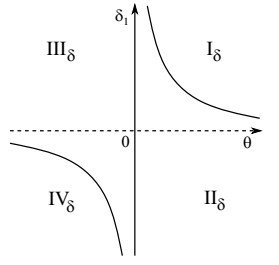









 DownLoad:
DownLoad:
